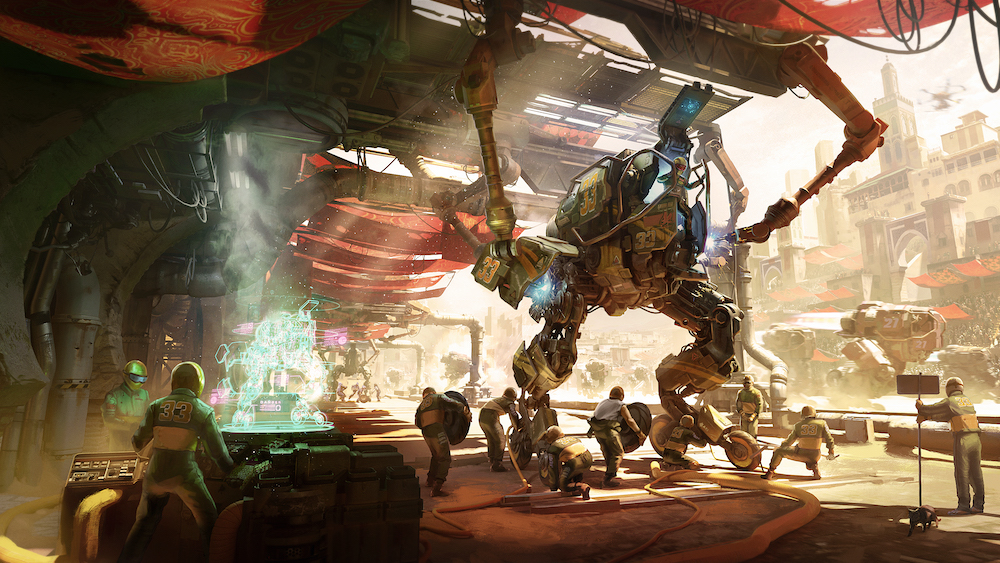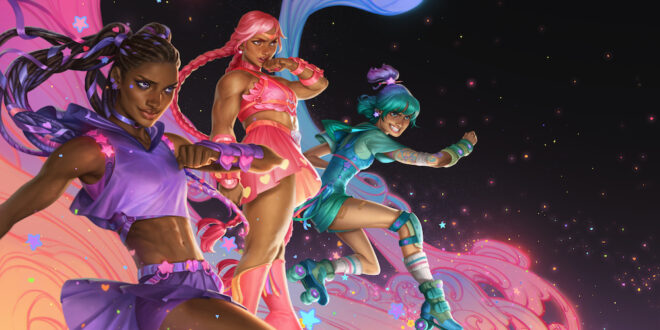Celebrating five years since joining the Sumo collective, Atomhawk managing director Tim Wilson brings us up to date on the state of the art.
Can you give a brief history of Atomhawk up until it was acquired by Sumo?
Atomhawk was founded in 2009 and was one of the first external development studios to offer high-quality concept art and design. The studio quickly found success across the entertainment industry working on a range of movies, video games and franchises. Atomhawk was acquired by Sumo Digital in 2017 and became one of the founding operating businesses of Sumo Group alongside Sumo Digital. Since the acquisition, Atomhawk has expanded its visual development services to the video game sector and works with a wide range of publishers and developers on triple-A titles.
What were the circumstances that resulted in the acquisition and what was that period like for the company?
The acquisition enabled us to realise the strategic plans we had to drive Atomhawk forward, whilst retaining our studio culture and unique journey in the process.
The intention was to retain a degree of independence from Sumo. Has that been the case?
Atomhawk has its own distinct client base and service lines and operates as a business within Sumo Group. That being said, we always enjoy collaborating with other studios in the group and have helped shape the look of titles like Little Orpheus for The Chinese Room and Spyder for Sumo Digital.
How has Atomhawk benefitted from being part of Sumo?
Being part of Sumo Group has allowed us to focus on delivering projects for our clients whilst knowing a lot of other key areas such as IT, HR and finance are being looked after in the background. Sumo has also invested significantly in our people and studio spaces, including bespoke new offices in Gateshead and Vancouver.

How has the Vancouver studio worked out?
We opened Atomhawk Canada in 2017 as a way for us to reach new markets and talent. Having a team based on the west coast of North America puts us in the same time zone and geography as development hubs such as Seattle, San Francisco, Austin, LA and Vancouver itself. We’ve utilised this to build long-term relationships with studios like EA (FIFA) and Microsoft (Age of Empires) which would have been very difficult to do remotely.
What have been the other milestones of the last five years?
Sustainable growth: Atomhawk has grown as a business every year in terms of headcount, revenue, and locations. Importantly, we’ve done this in a sustainable way that has allowed us to invest in our team and service lines whilst maintaining the values and culture that made Atomhawk such a success to begin with. Ultimately, this allows us to do more for our clients and help support them throughout the development of their games.
Annual Art Competition: Each year we set a theme and challenge the digital art community to create something that hits the brief. The competition has grown year on year, and we’ve unearthed some amazing talent along the way. The theme for 2022 is ‘Forgotten Creation’ and it’s always a highlight of the year to review the entries.
Other Worlds Exhibition: We recently held an exhibition of our work at The Great North Museum in Newcastle. This gave visitors an insight into the creative process and demonstrated the importance of using real-world design cues. A key part of the exhibition was working with local schools to show them that a career in video game art is viable right here in the North East of England.
It was also great to see digital art reproduced in a physical space. It’s often confined to screens so being able to experience their work in a gallery setting was a huge morale boost for our team. StudioQuest: Atomhawk partnered with ArtStation to create a series that goes behind the scenes of what it takes to be a professional digital artist. From initial client briefing and collaboration with team-mates, and through feedback loops and final delivery, this series touches on a wide range of topics at all stages of the visual development pipeline. We loved creating this series as it gave our team the opportunity to create a brand-new IP and also give some valuable insight to those looking to break into the industry.

Has there been a particular period or project that you consider a standout or defining moment for the company?
Atomhawk has contributed to an incredible range of franchises over the years, including Halo, FIFA, PUBG and Call of Duty. One standout partnership we have is with NetherRealm, who we’ve worked with since 2010 on chart-topping franchises like Injustice and Mortal Kombat.
What are the unique opportunities and challenges you have to deal with as a games studio devoted entirely to the visual arts?
Early access: We’re very fortunate to work on a lot of projects during their infancy. This is always exciting as you’re getting a glimpse at what gamers will be playing in 3 – 5 years’ time. Our artists get the opportunity to help shape the look of these games at a key phase in their development which is a big responsibility, but one we always enjoy as a team.
On the flip side, working on pre-release projects tends to mean most of our work becomes shrouded in secrecy until the games are announced by their developers. Sadly, some games also don’t make it past the early stages of development for a variety of reasons. It can be disappointing to have worked on a project that will never see the light of day as there is often a lot of amazing concept art that then has to remain unreleased, but our team appreciates this is simply part and parcel of the complicated process of making games.
Games as a Service (GaaS): Atomhawk is probably best known for concept art that sets the visual tone, and over the years we have built out our service lines to support art creation at all stages of the game development process.
Initially, this meant providing support in the preproduction, production and marketing phases, but a major stage now comes post-release in the form of downloadable content (DLC). As game life cycles have evolved to become service-based so too has the appetite and need for more content. Successful DLC needs to appeal to gamers and help keep them playing and invested in the game. Art plays a huge part in this success and can help sustain and refresh popular games for years beyond their initial release.
Innovation: Many of our clients come to us looking for art that will make them stand out. This is a big responsibility and requires our artists to push beyond what has been done before. We aim to hire creatively curious people who draw inspiration not only from games and media but also from the wider world beyond the screen.
Bringing together a diverse range of artists from across the world and then letting them collaborate is one of the keys to creating some special ideas. It’s also a lot of fun to be part of this kind of group and the community aspect is a big draw for a lot of the people that apply to work at Atomhawk.

What trends in game development are you keeping a close eye on in terms of how they might impact Atomhawk?
The increasing convergence of art and technology: We have seen an increasing need in the industry to provide technical solutions to art and design problems. Last year we opened Atomhawk Advance, a studio dedicated to technical art and user interface design. This team specialise in working in-engine to design and implement art solutions directly into videogame builds. They also work closely with our concept art team to build bespoke tools that help enhance their workflows. Our teams are constantly assessing new tools and software that they feel could be utilised in the art creation process. Many of these can help speed up artist workflows and allow them to create some mind-blowing pieces of work in short spaces of time.
The key thing to monitor though is that the tool doesn’t replace the idea. Ultimately, art still needs to stick to the fundamentals and help convey a story, mood, or idea in an impactful way. Technology like artificial intelligence, photogrammetry and procedural generation can take out some of the spadework in creating a polished piece of art but they still need to be directed and applied by a talented artist to be successful.
Expect the unexpected, then expect more of it once it arrives: A lot of industry-changing ideas seemingly come out of nowhere and then change the landscape forever. A good example of this is the battle royale genre. Very few would have predicted this mechanic or that it would become so wildly successful. It’s interesting to see other developers then take that model and riff on it in their own way with their own IP. We see a lot of briefs for new games which look to build on an existing trend in a fresh and distinctive way.

 MCV/DEVELOP News, events, research and jobs from the games industry
MCV/DEVELOP News, events, research and jobs from the games industry




